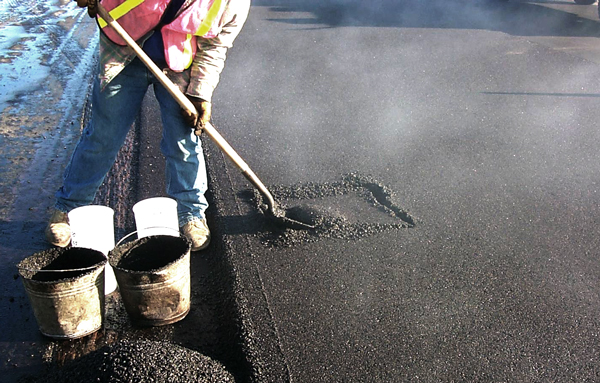Unlocking the Keys of Warm Mix Asphalt Modern Technology
Exploring the depths of warm mix asphalt modern technology discovers a world where precise formulations and thorough procedures converge to form our roads and infrastructure. The blend of binders, fillers, and aggregates isn't merely a building and construction task yet a critical orchestration of longevity and effectiveness.
Relevance of Warm Mix Asphalt
Hot Mix Asphalt plays a critical function in modern-day facilities development because of its resilience and cost-effectiveness. As one of the most typically made use of paving product for roads, freeways, and vehicle parking lots, Hot Mix Asphalt supplies a variety of advantages that add to its value in construction jobs. One vital advantage is its capability to withstand rush hour loads and harsh climate conditions, offering a reputable and durable surface for transportation networks. In Addition, Warm Mix Asphalt is economical in both first construction and long-lasting upkeep, making it a recommended choice for numerous facilities tasks.
The durability of Hot Mix Asphalt stems from its composition, which consists of accumulations, binder, and filler products that are meticulously picked and mixed to meet specific performance requirements. This precise combination results in a solid and adaptable pavement that can withstand constant usage without considerable deterioration. Hot Mix Asphalt is 100% recyclable, further enhancing its sustainability and ecological advantages. Generally, the value of Hot Mix Asphalt in infrastructure development can not be underrated, as it remains to be a foundation of modern construction techniques.
Elements of Asphalt Mixes
The composition of asphalt mixes consists of thoroughly picked accumulations, binder, and filler materials that are critical for achieving certain efficiency demands. Aggregates are the primary element of asphalt mixes, supplying toughness and stability. The binder, usually asphalt or asphalt concrete, holds the aggregates together and supplies versatility and durability to the mix.
The combination and proportion of these elements play a substantial duty in determining the quality and efficiency of the asphalt mix. Designers carefully design the mix to meet particular requirements, thinking about elements like web traffic volume, climate problems, and sidewalk life-span. Correct option and harmonizing of accumulations, binder, and fillers are crucial for developing sturdy, durable asphalt sidewalks.
Mixing and Production Methods

Once the aggregates are chosen, the binder, frequently asphalt concrete, is included to bind the products with each other. The binder's top quality and amount dramatically impact the mix's resistance, strength, and flexibility to ecological variables. In addition, fillers like moisturized lime or Portland cement may be incorporated to boost specific characteristics of the asphalt mix, such as its workability or dampness resistance.
Throughout manufacturing, the accumulations and binder are heated up, usually in between 250-325 ° F(121-163 ° C ), to promote blending and guarantee proper covering of the aggregates. The blending procedure should be comprehensive to Get More Info achieve an uniform blend that advertises the preferred efficiency characteristics of the asphalt. Numerous methods, such as batch blending or drum mixing, are employed to attain top notch and consistent asphalt blends for building and construction jobs.
Factors Influencing Asphalt Performance
Factors affecting asphalt performance incorporate a series of variables that influence the toughness, durability, and total high quality of asphalt sidewalks. One crucial factor is the high quality of products used in the asphalt mix. The kind and source of accumulations, the binder high quality, and the additives all play a substantial role in establishing the performance of the asphalt sidewalk. The gradation of aggregates is crucial as it influences the mix's workability, resistance, and stability to rutting and splitting.

Environmental problems also affect asphalt efficiency. Temperature variants, wetness seepage, and traffic lots can all affect the architectural stability of the pavement. Style considerations, such as sidewalk thickness and water drainage, are necessary in ensuring the long-lasting efficiency of the asphalt pavement. By very carefully considering these service providers, designers and factors can enhance asphalt efficiency and boost the life span of pavements.
Lasting Practices in Asphalt Innovation

In addition, the advancement of warm-mix asphalt (WMA) modern technologies has actually acquired traction in the last few years. WMA permits for the manufacturing and positioning of asphalt mixes at reduced temperature levels contrasted to standard hot-mix asphalt, leading to decreased power intake and greenhouse gas discharges. The usage of porous asphalt mixes can assist reduce stormwater runoff problems by enabling water to penetrate through the pavement and right into the ground, promoting natural water purification and recharge processes. By executing these lasting methods, the asphalt sector can add to constructing a much more environmentally pleasant and resilient infrastructure network.
Conclusion
Finally, hot mix asphalt innovation plays a vital function in modern-day facilities growth because of its toughness and cost-effectiveness. More Info By meticulously stabilizing components, utilizing correct blending methods, and considering numerous elements, designers can produce high-quality asphalt mixes that hold up against hefty traffic lots and extreme weather. Welcoming sustainable techniques, such as making use of warm-mix technologies and recycled materials, further enhances the ecological friendliness of asphalt innovation.
Mixing and production methods in warm mix asphalt technology involve the accurate combination and handling of accumulations, binder, and fillers to produce a long lasting and high-performance asphalt mix.Elements influencing asphalt efficiency incorporate a variety of variables that impact the resilience, longevity, and total high quality of asphalt pavements. Lasting methods in asphalt technology incorporate different initiatives intended at decreasing the environmental influence of asphalt production and paving procedures. By integrating reclaimed asphalt sidewalk (RAP) and recycled asphalt roof shingles (RAS) into brand-new asphalt mixes, the sector can substantially decrease the intake of raw materials and energy, while also lowering landfill waste.
WMA permits for the production and positioning of asphalt mixes at reduced temperatures contrasted to traditional hot-mix asphalt, resulting in minimized energy usage and greenhouse gas emissions.